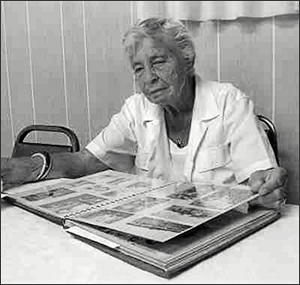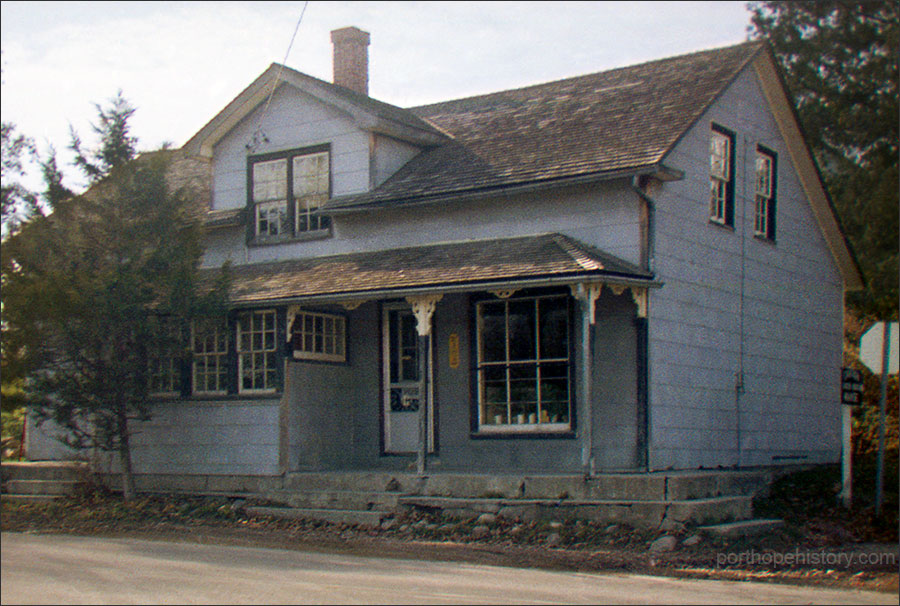Ethel Bickle's Book
click here to read 'In and Around Canton'from Northumberland Today Thursday, Jan 8, 2015
by Charles Beale
In the first column of 2015, I flash back to Port Hope’s hamlet of Canton. We often forget how rich local history is in every corner of Northumberland County. We have also become accustomed to relying on modern technology to provide quick facts. So it is heartening to be reminded
 that local families kept diaries, pasted news clippings into scrapbooks and filed early photos of their ancestors in albums that cemented pride in their heritage and long-standing family ties.
that local families kept diaries, pasted news clippings into scrapbooks and filed early photos of their ancestors in albums that cemented pride in their heritage and long-standing family ties.One such person was Ethel (Hawkins) Bickle whose relative [mother-in-law], Mary [Mary Martha Peters] Bickle, kept scrapbooks of early goings-on in and around Canton north of Port Hope. Ethel Bickle saved these after Mary’s death and added to them as she documented and published In and Around Canton in 1989, a history of Hope Township’s Canton village. Mrs. Bickle also relied on the Historical Atlas of Northumberland & Durham (Belden, 1878) and other well-known local sources for her research, including archiver Edna Barrowclough.
The Dodds Directory of 1880 recorded the progression of settlement in the area as being from Smith’s Creek (Port Hope) in 1796 to Dale Road in 1798, then to Welcome and Canton by 1805, followed by Perrytown in 1820 and finally Garden Hill and Elizabethville around 1830. An Edward E. Dodds Memorial plaque was installed in Canton Cemetery June 3,1987 in appreciation for Dodds’s service in the U.S. Civil War in 1864 before he moved [returned] north to Upper Canada.
Ethel Hawkins Bickle’s surroundings would always be second nature to her, but perhaps not to others who are unfamiliar with Canton’s location. The village began as many did in Ontario on a watercourse with the building of a mill; this one farther up the Ganaraska River. The settlement grew quickly with the addition of other mills, a school, church, store and taverns. Although residents in and a round Canton generally assign it a wider address, the actual confines exist north of Welcome on County Road 10 between the 4th and 5th lines of the former Hope Township.
Ethel Hawkins was born at the family’s Mount Airy homestead, north of Canton in the 3rd [5th] concession on Sept. 5, 1924 and lived all her 85 years in and around it. She was know for her generous spirit, but was frugal by nature having been raised during the Depression. Her background is in many ways the history of Canton itself. Founding families were Callendar, Harris, Peters, Powers and Salter, among others that would follow closely thereafter, but it was the Hawkins clan who hold pride of descendancy.
James Hawkins Senior (1759-1841) traveled to Port Hope from Coventry, Connecticut via Montpelier, Vermont in 1801. One of their six children was named Azel Hawkins who had a son, John Farley Hawkins. J.F. Hawkins also had a son named J. Fred Hawkins and it was J. Fred who had a daughter named Ethel - the one who wrote In and Around Canton.
Ethel would marry Morley Bickle in 1948 and they would have three sons – Farley, John and Bill – who to this day live in and around Canton. Farley and his family own the farm at the crossroads of Bickle Corners and County Road 10 (c.1908) while John and his family live in the Mount Airy property (c.1822) where Ethel was born and lived her first 24 years. Bill and his wife Marnie own the family’s 1840s White Cottage, again at Bickle Corners. There are other relatives once and twice removed by marriage who form part of the intertwining of the Hawkins legacy, including Dr. M.S. Hawkins who married Maude Bickle and for whom a school in Port Hope was named.
There is little left in Canton by way of industry or commerce, but the first wooden mill was built at the dam site on the Ganaraska River in 1825. In 1842, two other mills were erected; one by Samuel Powers who built it by trading an acre of land on the river with the same James Hawkins. By 1844 Peter Salter would improve the Canton mill facility and rename it Durham Mills. As times changed, the mill was sold on until it burned down in 1884, when it was rebuilt as a brick flour mill. Brands sold
cursor over or tap a face to see the name
then were Crown, Star and Excelsior. Former governor-general Vincent Massey’s name surfaces here again when he and a Professor Wrong bought the mill site in 1919 and rented it to E. Muir & Sons. Massey would become the sole owner of the mill by 1930 and would also purchase nearby Durham House (c.1820). Sadly, by 1952 the flour mill ceased operation, but was reinvented as a seed mill. It, too, ceased operation in 1967 and remained vacant for some time. Ian and Daphne Angus would buy the Batterwood estate on Massey Road from engineer David Hadden in 1988. Ian Angus, the former reeve of Hope Township, now uses the Canton mill for his law office.
The first log school was also built on James Hawkins land in 1820. Another clapboard one would be built on the 4th line and by 1855 the two school merged into SS Number 8 with its first elected trustees.
In 1819 Wesleyan Methodists would gather in Canton, east of the present church and before the first log school was built. By 1832, the first Methodist church was erected, again on Hawkins land and across the road from the Hawkins Cemetery. James’s wife Susan was the first settler interred there in 1811.The wooden church named Hope Chapel was a community mainstay and it wasn’t until 1876 that a brick church was built beside the chapel. For some time the chapel was then used as the Ladies Aid Hall for entertainment and teas. The Royal Orange Lodge and the Canton band also held sessions there for a period of time. In 1931, the church was folded into the new United Church of Canada denomination. It was here in 1948 that Ethel Hawkins and Morley Bickle were married. She would attend Canton United until her death in 2009. Canton United Church closed in 2012. Descendants of several early families remain board members of the Canton Cemetery Trust.
A store and post office traditionally formed an important hub of any small community and Canton was no different. The Hopeville Post Office, later renamed Canton Post Office, was established in 1856 along County Road 10 on land severed by Samuel Powers. The first postmaster was William Carr and mail was delivered by horse and coach. A store owned for many years by William Callender shared the main level of the frame storey-and-a-half building. By 1913 rural mail was instituted and by 1965, the post office was closed. Two years later the structure was torn down during the widening of the county road.

Canton Store and Post Office
picture from Julie Beckett
Ethel Hawkins Bickle described how temperance and taverns never had an easy relationship in Canton. It would be Dr. R. A. Corbett, residing in nearby Perrytown in 1865, who proposed a bylaw to prohibit alcohol in the township. The motion failed and by the late 1860s there were four hotels in the vicinity, but the Temperance Society became a vocal force and licences were limited while taverns were restricted to yearly renewals. By 1884, there were only two remaining tavern hotels and by 1895 only one. In 1906, Hope Township prohibited alcohol in public houses and, surprisingly, this bylaw remained in force until 1980.
Ethel Bickle’s book is full of images of the passing of time and local improvements. For example, when Dr. A.C. Beatty heard of the invention of the telephone in 1876, he took it upon himself to order phones and install them in 1895 in and around Canton. By 1909, he had established the Beatty Telephone Company in nearby Garden Hill.
Shortly after Ethel was born in 1924, hydro came to Canton. By 1937, CBC radio was airing from Toronto and would become a household staple. On the heels of these tremendous changes, refrigerators replaced ice boxes in the 1940s and ringer washers and the clothesline were being phased out for washers and dryers in the early 1950s. Television came to Canton in 1952.
Ethel Hawkins Bickle wrote in the preface to her book, "I imagine most everyone at one time or another has thought - I wish I had written that down, or I’d like to write a book about that" And so she did and by doing so she enriched the record in and around Canton.
Use the form below to comment on this article. A name is required, optional email address will not be revealed.